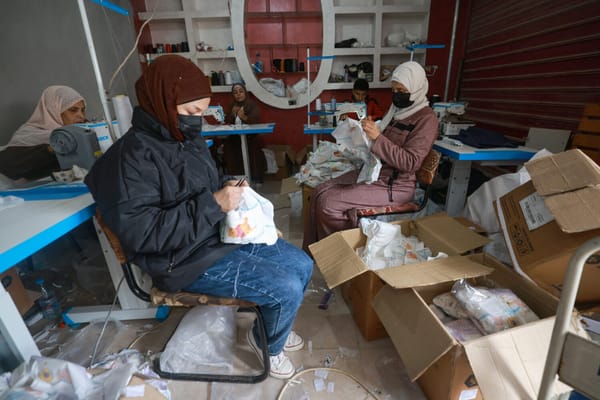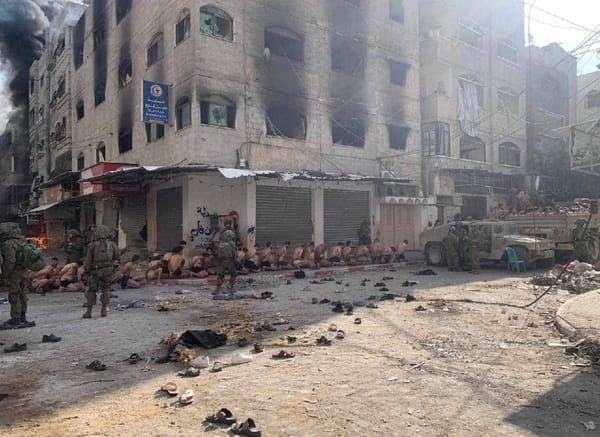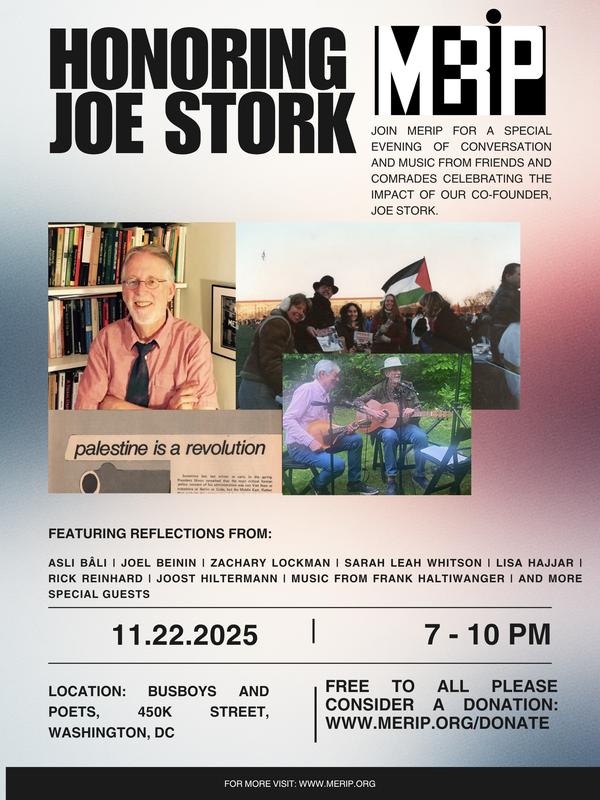Israel’s War on Reproduction in Gaza
Hala Shoman reports on reprocide as a tactic of eliminationist violence.


Hala Shoman reports on reprocide as a tactic of eliminationist violence.

In December 2023, an Israeli missile struck Gaza’s largest fertility clinic, Al Basma IVF Centre.

The single explosion destroyed more than 4,000 embryos and over 1,000 vials of sperm and unfertilized eggs. Dr Bahaeldeen Ghalayini, the obstetrician who established the clinic, summed up the implications of the attack in an interview with Reuters: “5,000 lives in one shell.”[1]
The strike was an act of reprocide: the systematic targeting of a community’s reproductive health with the intention of eliminating their future. In the context of Israel’s ongoing genocidal war in Gaza, reprocide serves as a tactic. Indeed, genocide includes its definition, “imposing measures intended to prevent births” within a particular national, ethnic or religious group.
The bombing of the IVF clinic was one spectacular example, but as a Palestinian women’s rights activist from Gaza, I have lived and witnessed how Israel uses reprocide within a settler colonial framework that seeks not only territorial domination but demographic erasure—a process that began long before October 7, 2023.
When I was 15 years old, following the Israeli assault on Gaza in 2008–2009, Israeli soldiers began wearing and distributing t-shirts that depicted a pregnant woman in crosshairs above the slogan “1 Shot 2 Kills.”[2] I recall the fear felt by the pregnant women I knew. The t-shirts prompted people around me to recount stories of pregnant women being killed or wounded during other moments of extreme violence in Palestinian history, from the start of the Nakba in 1948 to the Sabra and Shatila massacres in 1982. Underscoring the eliminationist nature of this violence, Israel remains among the world’s leaders in assisted reproduction technology, actively encouraging birth rates among Jewish citizens.
In an effort to trace the effects of reprocide amid Israel’s ongoing genocidal war, between October 2023 and October 2024, I collected ethnographic evidence—voice notes, text messages, emails and phone calls—from those enduring or witnessing reproductive violence. Analyzing their accounts alongside official reports from Gaza reveals the many ways Israel has weaponized reproduction, some more obvious than others: from the direct assaults on reproductive health and infrastructure to the conditions it forces women and men to reproduce under to sexual violence and its role in reproductive erasure.
By March 2025, the official death toll in Gaza since October 7, 2023 had surpassed 50,000.[3] More than 17,000 of the dead were children, including at least 2,100 infants and toddlers.[4] At least 970 extended families were wiped out entirely. Although the exact number of widows in Gaza is unknown, as early as January 2024, UN Women reported that there were at least 3,000 widows and an uncounted number of widowers. Illustrating the scale, in my own circle of friends, nine have become widows and 13 widowers.
Beyond the staggering death toll, which has prevented countless potential lives and future generations, the genocide has explicitly targeted Gaza’s capacity to reproduce. Even before the genocide, Gaza was a difficult place to be pregnant: A study on maternal mortality conducted in 2018, for example, suggests that, among other factors, the illegal Israeli blockade beginning in 2006 has impacted maternal mortality rates.[5] The siege reduced the availability of drugs, disposables and medical equipment. It also affected women's ability to get referrals and exit Gaza for emergency treatments, as their exit was subject to Israeli approval.
Since October 2023, the situation has become catastrophic. Between October and November of that year, around 180 women gave birth in Gaza each day, and at least 15 percent of them faced complications.[6] By 2024, more than 177,000 women experienced life-threatening health risks such as non-communicable diseases, hunger and malnutrition during their pregnancies, and the miscarriage rate had increased by up to 300 percent.[7]
Intensive Care Units have been repeatedly bombed and lack the life-saving electricity needed to supply incubators for premature babies. In November 2023, a harrowing example of the consequences of such attacks came when the Israeli army forced the abandonment of five premature babies at Al Naser Children’s Hospital. Soldiers ordered hospital staff to evacuate and leave the premature babies, where they died without support.
In addition to systematically destroying hospitals, fertility clinics and maternity wards, Israel has maintained an ongoing blockade of Gaza, which includes the obstruction of aid and medical supplies necessary to reproductive health. Since October 2023, hundreds of Palestinian women have endured C-sections without anesthetics, while doctors have had to remove entirely healthy uteruses to protect women’s lives amid the absence of hemorrhage controlling materials for postpartum bleeding.
In addition to systematically destroying hospitals, fertility clinics and maternity wards, Israel’s ongoing blockade of Gaza includes the obstruction of aid and medical supplies necessary to reproductive health.
In December 2023, I spoke to Dana, a 34-year-old woman who had spent ten years trying to conceive. When the Israeli military forced her and her husband to evacuate Gaza City, she was several months pregnant. At a checkpoint, female Israeli soldiers forced her to squat repeatedly, causing her to bleed and lose consciousness. Her husband carried her to a hospital, where the baby was born in poor health, and Dana hemorrhaged. With no access to medicine, doctors had to perform a hysterectomy. Dana survived, but her reproductive future did not. As with many of my friends and informants, I lost contact with her a long time ago and do not know whether she is still living.
While there is no precise number available, many pregnant women have not survived such attacks. In November of 2023, NBC News documented the story of Hind Shamlakh, a pregnant women who was buried under the rubble after an Israeli airstrike hit the home she was sheltering in. After being rescued, she was given an emergency c-section. The baby was born with a broken arm. My brother-in-law, an obstetrician, recounted that he performed ten postmortem C-sections in a single week in 2023, rescuing babies from the wombs of mothers who had died. When rescued, these infants struggle to survive without incubators, adequate formula or parental care.
Israel’s relentless bombardment of Gaza, particularly between October 2023 and the temporary ceasefire in January of 2025, has made the conditions of delivery traumatic and difficult, even for women with healthy pregnancies. Many women shared accounts with me of how they had to deliver in their sheltered areas as they were caged in by Israeli tanks and quadcopters. Some recounted how their husbands had to deliver them as they were unable to move or seek help amid the Israeli ground invasion. One friend described giving birth in a house surrounded by Israeli tanks. She was not able to cut the umbilical cord. Soon after the Israeli tanks withdrew, she decided to walk to the nearest hospital. Out of fear of indiscriminate attacks on civilians, she opted to go alone with her newly born baby, leaving her husband. If she was killed, then the rest of their children would have at least one parent left.
Since October 2023, Israeli attacks have damaged or destroyed nearly 70 percent of Gaza’s structures, including 92 percent of its housing units. Stephen Graham has referred to this kind of military tactic as “switching off cities.”[8] It leads to a situation he describes as “bomb now, die later.”[9] In other words, the systematic destruction of infrastructure and housing, combined with the obstruction of nutrition and medication, may not kill immediately, but it ensures a slow death. It also precludes the possibility of new life.
...the systematic destruction of infrastructure and housing, combined with the obstruction of nutrition and medication, may not kill immediately, but it ensures a slow death. It also precludes the possibility of new life.
The consequences of this infrastructural destruction are vast when it comes to reproductive health. For example, Israel’s destruction of Gaza has created a toxic physical environment. Bombing, rubble, white phosphorus and other chemical debris resulting from the Israeli bombardment (85,000 tons of bombs in the first 13 months) has led to severe environmental hazards for pregnant women and children and a sharp rise in the rate of fetal abnormalities. According to Mohammed Abu Afesh, the director of Medical Relief in Gaza city and the Northern Governorate, as many as one in four newborns is affected. Polluting agents from munitions and debris increase pregnancy complications, including infections, anemia, preeclampsia and stillbirths. They also lead to children’s medical issues, including wounds that won’t heal and early osteoarthritis, not to mention the severe psychological toll, ensuring that the new generation, if born, will continue to suffer.
Combined with this pollution, Gaza faces conditions of extreme hunger and inadequate sanitation due to the absence of supplies, aid and electricity to treat wastewater. Women report being unable to breastfeed or to find formula. In Rafah, a sewing factory began manufacturing diapers out of lab coats, medical cotton and gauze, due to their scarcity following the complete blockade.
Amir, a friend of mine who is 30 years old, described the devastating effect this lack of basic supplies had on his family. Four months into the genocide, Amir and his wife had a baby girl, Amira. For six months, they fought to keep her healthy. When she was ready to switch to solid food, Amir struggled to find it. Soon after, she caught an infectious disease, but they could not access an ICU: The nearby hospital was at capacity, and the family was unable to cross to the South due to Israeli closures and a blockade over the northern part of the Strip. Without access to care, Amira died in front of her parents at only 6 months old, before having the chance to eat chicken or meat or to taste fruits or any food that was not from a can. This trauma will affect the couple’s reproductive choices in the future. They struggle to imagine having another child, especially during the genocide, and they are not alone. Many mothers I spoke to expressed wishing to have their babies back in their wombs.
Beyond the marked environmental health impacts, the complete disruption to Gaza's social fabric and built environment also affects everyday intimacies that enable reproductive futures. Israa Saleh is a doctor in Gaza who specializes in sexual and reproductive health. She currently works with Doctors of the World. In a wide-ranging interview in September 2024, she explained how difficult intimacy has become for couples in the Gaza Strip, especially at shelters, where the forced displacement of 90 percent of Gaza’s population and the absence of adequate shelter and overcrowding has led to a lack of privacy that deeply impacts intimate relationships and sexual experiences.[10] In the interview, Saleh describes the improvised solutions for privacy and how they run up against overcrowding and community traditions around intimacy. “There is a classroom which is for couples if they want to live the reproductive or sexual experience,” she says.
Following October 7, Israel enacted near daily detentions of Palestinians across the West Bank and East Jerusalem. By the end of 2024, nearly 10,000 Palestinians were being held in Israeli prisons on “security grounds,” including more than 2,000 from Gaza.[11] Palestinians from Gaza have been abducted by Israeli forces and held without communication in military facilities.
The indefinite detention of Palestinian political prisoners, without due process and under conditions of sexual abuse and torture, also has reproductive consequences. While conditions for Palestinian prisoners raised significant concerns before October 7, reports since have indicated a dramatic worsening. In a report released in July 2024, the United Nations Office of the High Commissioner of Human Rights (OHCHR) documented sometimes daily raids of prison cells, where basic hygiene items, including menstrual pads, are confiscated.[12] Prisoners have been denied access to lawyers and their families, barring them from contact with the outside world.
Also Read: "Israel Is Waging War on Palestinian Prisoners," MER issue 312, Fall 2024.
Palestinian men and women prisoners, as well as male and female children in detention, have reported sexual and gender-based violence at the hands of male and female Israeli soldiers. These reports have included the forced nudity of both men and women, beatings and electrocutions to the genitals, humiliating strip searches, sexual slurs, threats of rape and sexual assault.[13]
In military detention centers like Sde Teiman, prisoners have reported extreme acts of torture and sexual violence: Israeli male and female soldiers have raped Palestinian male detainees with metal rods, beaten their genitals and urinated on them. Surveillance footage from the prison has corroborated this testimony. Ibrahim Salem, a 36-year-old Palestinian man at the center of a viral depiction of prisoner abuse in Sde Teiman, described the experience in an interview with Middle East Eye in August 2024. “Nothing was more humiliating than when they made me take off my clothes, or when they inserted this object into my butt, or when a young female soldier kept [touching my penis],” he said.[14] His words underscore how the targeting of men, and their humiliation by female soldiers in particular, is an act intended to crush Palestinian dignity and stamp out all traces of resistant masculinity.
Palestinian female prisoners in Sde Teiman, as well as those detained elsewhere, also report sexual violence, including filmed, forced nudity and rape, sometimes by multiple soldiers. The same OHCHR report documented a case of a pregnant Palestinian woman who was threatened with rape while in detention.[15] It further includes a detailed series of allegations of sexual violence enacted against women in detention. Like male prisoners, women report being sexually violated in the course of strip searches, beaten while naked and filmed in an effort to humiliate them.
This carceral violence cannot be separated from reproductive genocide: It involves a direct attack against women's and men's sexual and reproductive health.
This carceral violence cannot be separated from reproductive genocide: It involves a direct attack against women's and men's sexual and reproductive health. Victims and survivors of sexual abuse and rape suffer from mental health challenges—post-traumatic stress disorder, anxiety, depression and dissociation—that can have long term effects on their sexual relationships and ability to engage in intimacy. Torture targeting their genitalia can also result in physical health issues that impact their ability to perform sexually.
Sexual violence, moreover, carries consequences beyond the individual: It scars entire communities. Survivors may be ostracized, some may face forced pregnancies, while others may decide never to have children.
In late August 2024, Dr Mohammed Saqr, media spokesperson for Nasser Medical Complex in Khan Younis, addressed a statement to the international community on the shortage of medical supplies and aid. "With the scarcity of medical supplies in emergency departments, we are now focusing on saving children and women to preserve the Palestinian lineage in Gaza,” he said.[16]
His comment highlights that Palestinians are aware of reprocide and grappling with how to counter it. It also reveals an effort to resist, through a focus on women and children, the ongoing eliminationist violence that targets these groups, specifically, in order to target social reproduction. As Layal Ftouni has written: “Not only are Palestinians as a wholesale racialized population deemed enemies of the state; the figure of the woman and the child are particular signifiers of the ‘enemy's’ reproductive capacity to live on, to mutate.”[17]
Some of those I have spoken to are equally explicit in their desire to continue producing as an act of resistance and life affirmation in the face even of their own deaths.In the same interview mentioned above, Dr. Saleh describes a man in Gaza visiting her clinic. “I want to have a child before being killed,” he told her. Such accounts are coming from a community acutely living through a reproductive genocide, who are suffering from a collective fear of extermination and elimination. In 2024, a video went viral depicting a father after losing his six children in a strike. “They kill our children, so we do not survive,” he told the camera, going on to vow that they would have more children so they would never be annihilated. These actions can be summed up by the slogan, popular in English and Arabic, “existence is resistance” (al-sumud muqawama).
Indeed, just as Israel’s targeting of Palestinians’ reproductive capacities is not new, efforts, like the above, of Palestinians to counter reprocide precede the current genocide. Take the increasing practice of smuggling the sperm of Palestinian prisoners from Israeli prisons to their wives on the outside; some IVF clinics will inseminate free of charge. Children born from sperm smuggling are considered illegal by Israel, and Israeli authorities deny them any identification documents. Conversely, following October 7, 2023, Israeli courts have removed legal barriers to obtaining and freezing semen from dead Jewish Israelis, including allowing parents to consent to this sperm being used on behalf of the deceased. According to the Israeli health ministry, as of July 2024, sperm had been retrieved from almost 170 men—both civilians and soldiers and including those without legal partners.
Other Palestinians I have spoken to have reached the opposite conclusion. Although they wish to have children, they cannot imagine doing so in these conditions. On August 6, 2024, I myself posted a message on social media urging newly married couples in Gaza to delay pregnancy if they could. It was a plea wrapped in love and fear:
May God bring them happiness, but they should be careful about having children right now. Pregnant women, mothers, and infants are suffering the most in the ongoing genocide. The miscarriage rate has increased by 300%, and the rates of infant and maternal deaths/stillbirths during childbirth, or mothers losing their uterus due to pregnancy complications and lack of medical resources, make pregnancy extremely dangerous at this time. Additionally, there is a shortage of milk, high levels of pollution, and numerous diseases. Please take care and use protection. May God protect and bless everyone.
I thought a lot before writing the post. I wavered between the right of parents to have children and the reality that their pregnancy, amid Israel’s campaign of reproductive violence, could lead to harm for the mother and the infant. I wrote on behalf of the mothers writing to me in desperation to ask other parents to postpone pregnancy and save themselves and their babies from this imminent fear and suffering. At the same time, I wanted to avoid inadvertently echoing the logic of Israel’s ongoing reprocide on Palestinians. But in conditions of reproductive genocide, countering this violence does not only involve physically reproducing. It involves making the conditions of life possible, something Palestinians in Gaza, whether they choose to have children now or delay, are continuing to do in the face of unprecedented and seemingly unchecked eliminationist violence.
[Hala Shoman is a PhD researcher in politics and sociology at Newcastle University.]
[1] Reuters, “‘5,000 lives with one shell’: when Israel hit an IVF unit,” YouTube, April 17, 2024.
[2] “Israeli T-Shirts Joke About Killing Arabs,” CBS News, March 23, 2009.
[3] "Israel’s war on Gaza has killed 50,000 Palestinians since October 2023," Al Jazeera, March 23, 2025.
[4] "The bloodiest face of its genocide: Israel has killed 2,100 Palestinian infants and toddlers in Gaza," EuroMed Monitor for Human Rights, August 14, 2024.
[5] B. Böttcher, N. Abu-El-Noor, B. Aldabbour, F. N. Naim and Y. Aljeesh, "Maternal mortality in the Gaza strip: a look at causes and solutions," BMC pregnancy and childbirth 18 (2018) pp., 1–8.
[6] “Women and newborns bearing the brunt of the conflict in Gaza, UN agencies warn,” World Health Organization, November 3, 2023.
[7] UN Women, "Gender Alert: Gaza: A War on Women's Health," September 2024; Report: “Five Babies in One Incubator," Human Rights Watch, January 28, 2025.
[8] Stephen Graham, Cities Under Siege: The New Military Urbanism (Verso, 2010).
[9] Ibid, p. 265.
[10] Ahmad Biqawi (with Israa Saleh), “How Do Women in Gaza Give Birth Under the Rockets?” YouTube, September 5, 2024.
[11] "Statistics on Palestinians in Israeli custody," B’Tselem, March 3, 2025.
[12] "Thematic Report: Detention in the context of the escalation of hostilities in Gaza (October 2023-June 2024),” UN Human Rights OHCR Report, July 31, 2024, p. 9.
[13] Ibid, pp. 12–13.
[14] Mohammed al-Hajjar and Nader Durgham, “‘Raped by female soldiers’: Palestinian in leaked Sde Teiman photo speaks out," Middle East Eye, August 8, 2024.
[15] "Thematic Report: Detention in the context of the escalation of hostilities in Gaza (October 2023-June 2024),” UN Human Rights OHCR Report, July 31, 2024, p. 13.
[16] Mohammad Sio, "Gaza hospital prioritizes women, children amid medical supply shortage," Anadolu Agency, August 23, 2024.
[17] Layal Ftouni, "'They Make Death, and I'm the Labor of Life' Palestinian Prisoners' Sperm Smuggling as an Affirmation of Life," Critical Times 7/1 (April 2024), p. 97.








